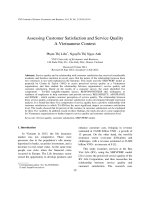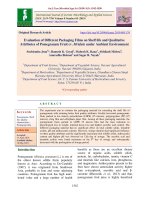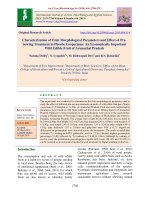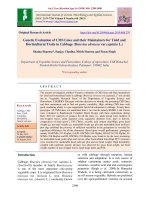Evaluation of morphological traits and fruit quality of Vietnamese pumpkin collection
Bạn đang xem bản rút gọn của tài liệu. Xem và tải ngay bản đầy đủ của tài liệu tại đây (128.72 KB, 6 trang )
Vietnam Academy of Agricultural Sciences (VAAS)
EVALUATION OF MORPHOLOGICAL TRAITS AND FRUIT QUALITY
OF VIETNAMESE PUMPKIN COLLECTION
Tran Danh Suu*1
Abstract
Fi y Vietnamese pumpkin accessions were evaluated for agro-morphological characteristics and fruit quality. e
experiment was continuously designed without replication. ere was a remarkable variation in expression of leaf
and fruit traits such as leaf size, fruit shape, fruit esh quality. e range of rst owering was 82 - 121 days a er
growing and the early owering was observed in Phac deng cham variety (T11497). Co nhum variety (T11505)
produced the maximum number of 16 fruits/plot and with highest yield of 12.76 tons/ha. ese varieties (Phac deng
cham and Co nhum) can be used directly or as good materials for breeding purposes.
Keywords: Pumpkin, morphological characteristics, yield
INTRODUCTION
Methods
Pumpkin (Cucurbita moschata) belonging to family
Cucurbitaceae is a very popular vegetable in many
tropical and subtropical countries. Pumpkin is
very nutritious due to high content of vitamin and
minerals. A lot of pumpkin parts can be used as food
including young leaves, stems, owers, fruits and
seeds. Pumpkins are very versatile in their uses for
cooking and have an advantage over other vegetables
as the fruits can be stored for up to 6 months before
being consumed and hence can play an important
role in maintaining nutritional levels during long
time (Ahamed KU et al., 2011).
e experiment was continously designed without
replication. Seeds were sown in a plate and planted
when having 2-3 leaves. Two rows were performed on
each bed and hole – hole was 0.75 m. Plot area for
each accession was 15 m2.
e agro-morphological traits were collected and
characterized by using descriptors of International
Union for the Protection of new Varieties of Plants
(UPOV, 2007).
Fertilizer application for 1 ha: 25 tons of manure + 250
kg urea + 450 kg super phosphate + 300 kg potassium
fertilizers
In Vietnam, pumpkin is grown in over the country,
especially, it is present in almost of farmer’s gardens
in Northern mountainous provinces and is becoming
a valuable commodity for farmers to get earnings
(Le Tuan Phong and Le Kha Tuong, 2011).
Time and place of the study
e experiment was carried out in Spring crop season
of 2014 at the Plant Resources Center, An Khanh,
Hoai Duc, Hanoi.
Many pumpkin genotypes having diverse
characteristics grown and genotypes available in the
market do not have uniformity or standardization
in nomenclature. At present, nearly one thousand
pumpkin accessions have been collected and
maintained at the National Genebank (Nguyen i
Tam Phuc, 2014). Moreover, no information on
morphological and agronomical characteristics is
available which can be used for direct use, breeding
and conservation of pumpkin genetic resources.
erefore, the evaluation of pumpkin collection is
necessary for above purposes.
MATERIALS AND METHODS
Materials
50 Vietnamese local pumpkin accessions maintained
at the National Genebank of the Plant Resources
Center were used for evaluation.
1
*
RESULTS AND DISCUSSIONS
Agro-morphological quantitative traits
Six agro-morphological traits including cotyledon
length, cotyledon width, internode length, leaf length,
leaf width and days to 50% owering of 50 pumpkin
accessions were evaluated (Table 1).
Cotyledon length and width: Signi cant variation
among the pumpkin accessions was observed for this
trait. e cotyledon length varied from 26 mm to 44
mm and the cotyledon width was 17 - 29 mm, the
coe cient of variation of cotyledon length was 11.3%
and of cotyledon width was 10.8%.
Internode length: e most variation was observed
for internode length among 50 studied pumpkin
accessions. is trait varied from 10.4 cm to 21.1 cm
with the coe cient of variation of 15.2%.
Leaf length and width: Varied from 21.8 to 36.6 cm in
leaf length, accession number 7535 had the highest
Vietnam Academy of Agricultural Sciences
Corresponding author: Tran Danh Suu. Email:
18
Journal of Vietnam Agricultural Science and Technology - No.1(3)/2018
leaf length (36.6 cm). Leaf width was 20.1 - 34.3 cm;
the highest leaf diameter (34.3 cm) was recorded
in accession number 7535. So the pumpkin variety,
Tau da (7535) collected from anh Hoa province
had the highest leaf length and width. Grubben and
Ngwerume (2004) also reported that leaf diameter of
C. moschata was 20 - 35 cm in diameter.
Days to 50% owering: e maximum number of days
to 50% owering determined to be 121 days a er
growing and the minimum number was 82 days a er
growing. It was observed that earliest ower opening
in the accession number T11497 (82 days) and the
longest in accession No. T11430.
Table 1. Agro-morphological quantitative traits of pumpkin collection
No Acc. No
1
2
3827
3861
3
3865
4
5
7530
7535
6
8577
7
8
9
10
11
9073
9631
T11425
T11429
T11430
12
T11431
13
14
15
16
17
18
19
20
21
22
23
24
25
26
27
28
29
30
T11432
T11436
T11439
T11440
T11446
T11453
T11454
T11455
T11462
T11463
T11468
T11473
T11474
T11476
T11477
T11483
T11488
T11490
31
T11492
32
T11493
Leaf
Cotyledon Cotyledon Internode
length
Cultivar Name
length
width
length
(cm,
(mm)
(mm)
(cm, n=9)
n=5)
Bi do
Son La
32
18
17.6
28.1
Bi do
Quang Binh
33
19
21.1
34.8
ua ien
Bi do
29
18
18.1
30.4
Hue
Ca deng
Bac Giang
31
20
14.4
26.2
Tau da
anh Hoa
33
24
18.2
36.6
Chum qua
Bac Giang
32
21
15
28
meng dang 1
Ma u
Son La
32
20
15.5
30.8
Nham
Hoa Binh
33
21
15.4
30.2
Cung qua
Ha Giang
38
22
14.8
28.6
Nong tau
Ha Giang
33
21
16.4
31.6
Nong tau da
Ha Giang
37
23
18.1
23.2
Pho nhum
Ha Giang
35
22
17.8
24.1
nhim
Mac phac
Ha Giang
39
24
17.6
29.2
Ma u
Dien Bien
26
18
15.9
25.9
Pia do din
Dien Bien
41
23
18.9
26.8
Tau da
Dien Bien
42
24
14.7
27
Phan qua
Lao Cai
35
20
12.6
26.5
Ma de axi
Dien Bien
44
26
15.9
31.4
Ma de axi to
Dien Bien
32
20
10.4
28.2
Ma de
Dien Bien
38
25
12.9
31.2
Ma u
Dien Bien
38
22
14.8
28.7
Lang qua
Dien Bien
39
23
13.5
28.6
Ma u
Dien Bien
43
29
18.6
30.2
Tau
Dien Bien
42
26
13.7
22.7
Pe u
Dien Bien
41
25
12.7
24.4
Nong tau
Dien Bien
44
26
12.2
24.7
Nong tau
Dien Bien
39
24
13.9
29.4
Phac Deng
Bac Kan
38
22
13
27
Nhum
Bac Kan
40
22
12.3
21.8
Tau da
Bac Kan
39
23
17.8
30.8
Qua nhum
Bac Kan
40
24
20.2
30
vieng
Phac deng
Bac Kan
38
24
17.4
32.2
Collecting
place
Leaf
width
(cm,
n=5)
27.5
33.8
Days
to 50%
owering
105
105
29.2
107
24.4
34.3
113
117
27.2
103
29.8
30.2
27.4
29.4
23
115
106
108
103
121
23.3
115
27.8
25.4
27.8
26.4
27
31
28
29.8
27.8
27.2
29.4
21.7
23
24.5
28.9
26.3
20.1
29.6
107
116
113
108
105
101
103
101
105
108
113
107
108
112
103
101
102
105
29.4
106
29.2
108
19
Vietnam Academy of Agricultural Sciences (VAAS)
Table 1. Agro-morphological quantitative traits of pumpkin collection (cont.)
33
34
35
36
37
38
39
40
41
42
43
44
45
46
47
48
49
50
T11495
T11496
T11497
T11499
T11500
T11505
T11507
T11508
T11512
T11515
T11516
T11520
T11531
T11532
T11533
T11535
T11536
T11537
Phac deng
Phac deng nua
Phac deng cham
Phec qua
Phac deng nua
Co Nhum
Nhum
Nhun
Nhum
Phac Deng
Phac Deng
Phac Deng
Kho nhum
Kho nhum
Pau nhum yang
Nhum
Nhum
Qua deng nua
Min
Max
Average
STDEV
CV (%)
Bac Kan
Bac Kan
Bac Kan
Bac Kan
Bac Kan
Bac Kan
Phu o
Phu o
Phu o
Cao Bang
Cao Bang
Cao Bang
Cao Bang
Cao Bang
Cao Bang
Cao Bang
Cao Bang
Cao Bang
37
37
30
37
36
40
31
34
34
38
36
36
37
37
44
34
41
39
26
44
36.7
4.1
11.3
Qualitative morphological traits of pumpkin collection
Ten qualitative morphological traits of 50 pumpkin
accessions were evaluated (Table 2). Among 10
morphological traits, there were 6 traits with the
same characteristics in all 50 pumpkin accessions,
such as angular stem shape, present tendrils, ovate
22
23
17
22
23
21
20
21
23
23
23
22
23
24
28
23
22
23
17
29
22.4
2.4
10.8
18.5
13.7
13.1
16.9
13
15.4
15.1
11.7
16.4
14.8
18.5
15.1
18.4
16.3
11.4
19
15.2
15.1
10.4
21.1
15.6
2.5
15.8
31.8
28.2
28.6
28.6
30.3
30.8
28
27.2
30.6
25.3
31.1
31.6
30.2
28.5
23
28.2
30.2
33.4
21.8
36.6
28.7
3.1
10.7
29.5
26.6
28.4
26
28.8
27.3
25.4
25.9
30.2
24.9
29.3
28.5
28.3
26.8
21.9
26.2
27.2
28.2
20.1
34.3
27.4
2.8
10.2
111
105
82
84
88
96
100
101
100
96
101
106
108
109
108
96
104
95
82
121
104.8
7.6
7.3
leaf shape, dented leaf margin, high leaf pubescence
(ventral surface), yellow ower and monoecious sex
type. ere were two types of leaf color; the rst type
(18 acc.) was interm and the second one (32 acc.) was
dark green. e predominant leaf lobs were interm
(41 acc.); the shallow and deep leaf lobs were rare.
Table 2. Qualitative morphological traits of 50 pumpkin accessions
No
1
2
3
20
Traits
Stem shape
Tendrils
Leaf shape
4
Leaf color
5
Leaf margin
6
Leaf lobes
7
Leaf pubescence (ventral surface)
8
Leaf pubescence (dorsal surface)
9
10
Flower colour
Sex type
Characteristics
Angular
Present
Ovate
Interm
Dark green
18
32
Dented
Shallow
Interm
Deep
5
41
4
High
Interm
High
40
10
Yellow
Monoecious
Total
50
50
50
50
50
50
50
50
50
50
Journal of Vietnam Agricultural Science and Technology - No.1(3)/2018
Characteristics of fruits
e fruit number per plot of 50 studied pumpkin
accessions varied from one fruit to 16 fruits per plot.
ere were 3 accessions with only one fruit (acc.
number 7535; T11436 and T11439) and the highest
number of fruits was recorded in pumpkin accession
T11505 with 16 fruits. e fruit weight of pumpkin
genotype 3861 (2.058 g) was the heaviest, closely
followed by T11453 (2.217 g) and the minimum
fruit weight was obtained from genotype T11439.
Grubben and Ngwerume (2004) reported that fruit
weight varied widely. e highest yield was recorded
in genotype T11505 (12.76 tons/ha) followed by
7530 (10.63 tons/ha), 3861 (10.03 tons/ha); genotype
T11439 had the lowest yield (0.33 tons/ha). Signi cant
variations were also observed among the accessions
in seed characteristics for dry weight of 100-seeds,
ranging from 4.3 g to 14.1 g (Table 3).
Table 3. Characteristics of fruits of 50 pumpkin accessions
No
Acc. No
1
2
3
4
5
3827
3861
3865
7530
7535
6
8577
7
8
9
10
11
12
13
14
15
16
17
18
19
20
21
22
23
24
25
26
27
28
29
30
31
32
9073
9631
T11425
T11429
T11430
T11431
T11432
T11436
T11439
T11440
T11446
T11453
T11454
T11455
T11462
T11463
T11468
T11473
T11474
T11476
T11477
T11483
T11488
T11490
T11492
T11493
Name of
varieties
Bi do
Bi do
Bi do
Ca deng
Tau da
Chum qua meng
dang 1
Ma u
Nham
Cung qua
Nong tau
Nong tau da
Pho nhum nhim
Mac phac
Ma u
Pia do din
Tau da
Phan qua
Ma De Axi
Ma De Axi to
Ma De
Ma u
Làng qua
Ma u
Tau
Pe u
Nong tau
Nong tau
Phac Deng
Nhum
Tau da
Qua nhum vieng
Phac Deng
Number
of fruits
per plot
2
6
4
11
1
Fruit
length
(cm)
8.8
14.8
10.9
10.9
14.7
Fruit
width
(cm)
11
16.4
14.6
15.3
7.7
Fruit
weight
(g)
550
2,508
1,200
1,450
1,200
0.73
10.03
3.2
10.63
0.8
100 seed
weight
(g)
6.2
12.2
8.4
10.2
4.3
5
11.8
16.5
1,680
5.6
11.3
5
5
8
9
2
2
8
1
1
3
2
3
4
5
2
3
6
3
4
2
12
12
10
5
6
7
9.6
9.9
9.8
15.3
14
11.6
14.2
16
16
11.9
14.4
28.1
29.3
30.6
11.8
12
14.7
10.2
12.6
14
11.1
9.9
10.4
24.9
9
8.5
11.7
16.1
14
15
10
13.9
13
10.5
9.5
12.1
14.4
14.6
11
10.1
14.2
13.4
15.5
12.3
15.2
10.7
12.7
13.1
14.7
10.7
14.8
13.8
910
1,176
1,178
1,468
650
1,300
1,184
900
500
1,000
1,500
2,217
1,150
1,526
1,275
1,217
1,902
900
1,613
735
1,190
1,142
1,080
1,220
1,200
1,080
3.03
3.92
6.28
8.81
0.87
1.73
6.31
0.6
0.33
2
2
4.43
3.07
5.09
1.7
2.43
7.61
1.8
4.3
0.98
9.52
9.14
7.2
4.07
4.8
5.04
4.9
8.7
8.1
12.3
8.9
6.5
10.6
10.1
10.1
7.9
11.9
10.2
9.6
10.7
10.4
8.6
10.2
9.9
9.1
6.2
7.8
8.7
10.6
12.5
9.1
9
Yield
(ton/ha)
21
Vietnam Academy of Agricultural Sciences (VAAS)
Table 3. Characteristics of fruits of 50 pumpkin accessions (cont.)
33
34
35
36
37
38
39
40
41
42
43
44
45
46
47
48
49
50
T11495
T11496
T11497
T11499
T11500
T11505
T11507
T11508
T11512
T11515
T11516
T11520
T11531
T11532
T11533
T11535
T11536
T11537
Phac Deng
Phac Deng Nua
Phac deng cham
Phec qua
Phac deng nua
Co Nhum
Nhum
Nhun
Bao Bi
Phac deng
Phac deng
Phac deng
Kho nhum
Kho nhum
Pàu nhum yang
Nhum
Nhum
Qua deng nua
Min
Max
Average
STDEV
CV (%)
3
13
6
5
5
16
5
5
7
8
7
5
12
2
7
12
7
5
1
16
5.8
3.5
61.2
Qualitative characteristics of fruits
Five types of the fruit shape were observed and
ranged from globular to elongate. e predominant
shapes were globular (27 acc.) and pyriform (14 acc.).
Flattened, elliptical and elongate shapes were rare.
e fruit ribs were absent in 17 and super cial in 29
accessions. e fruit skin colour and the esh colour
8
7.5
16.4
9.8
11.8
9
16
11.3
24.2
10.6
10.7
15
11
12
10.7
23.7
11.5
15.7
7.5
30.6
13.7
5.5
39.8
15.1
13
14.4
11.8
11.2
13.1
12.3
13.9
11.2
16.3
15.9
14.1
13.7
14.4
12
11
15
15.5
7.7
16.5
13.2
2.1
15.5
800
636
1,368
754
646
1,196
1,270
1,126
1,224
1,804
1,470
1,540
1,230
1,200
886
1,130
1,452
1,656
500
2508
1,223.8
395.9
32.4
1.6
5.51
5.47
2.51
2.15
12.76
4.23
3.75
5.71
9.62
6.86
5.13
9.84
1.6
4.13
9.04
6.78
5.52
0.33
12.76
4.8
3.1
64.6
6.6
7.9
14.1
11.3
9.5
8.8
13.2
6.5
8.2
10.1
9.1
12.1
10.6
12.9
7.1
10.5
10.2
11.1
4.3
14.1
9.5
2.1
22.3
at maturity were orange in all 50 studied pumpkin
accessions. 32 pumpkin genotypes had sweet in esh
avor while other 5 genotypes had insipid esh avor
and the rest 13 genotypes were intermediate (Table 4).
In previous study, Gerardus (2004) and Nguyen i
Tam Phuc (2014) also reported that the fruit shape
was diverse.
Table 4. Qualitative characteristics of fruits observed on 50 pumpkin accessions
No
22
Traits
1
Fruit shape
2
Fruit ribs
3
Predominant fruit skin
colour at maturity
4
Flesh colour
5
Flesh texture
6
Flesh avor
Characteristics
Globular
Flattened
Elliptical
Pyriform
Elongate
27
3
4
14
2
Absent
Super cial
Intermediate
17
29
4
Total
Orange
50
Yellow
1
Smooth- rm
16
Insipid
Intermediate
5
13
Orange
49
Fibrous-gelatinous
34
Sweet
32
50
50
50
50
50
Journal of Vietnam Agricultural Science and Technology - No.1(3)/2018
CONCLUSIONS
ere was a remarkable variation in expression of
leaf and fruit traits in 50 pumpkin accessions such
as leaf size, fruit shape, and fruit esh quality. e
range of rst owering was 82 - 121 days and the early
owering was observed in Phac deng cham variety
(T11497). Co nhum variety (T11505) produced the
maximum number of 16 fruits/plot and with highest
yield of 12.76 tons/ha. 32 pumpkin accessions had
sweet esh avor.
ACKNOWLEDGEMENT
e author would like to thank Dr. Tran i u Hoai
and Mrs. Nguyen
i Tam Phuc from the Plant
Resources Center for their help during the
experimental implementation.
REFERENCES
Ahamed KU, B Akhter, MR Islam, N Ara and
MR Humauan, 2011. An assessment of morphology
and yield characteristics of pumpkin (Cucurbita
moschata) genotypes in Northern Bangladesh.
Tropical Agricultural Research Extension 14(1): 7-11.
Gerardus J. H. Grubben, 2004. Vegetables (Prota 2).
Plant Resources of Tropical Africa, pp. 263-278.
Grubben GJH and Ngwerume FC, 2004. Cucurbita
moschata Duchesne In: Grubben, G.J.H. & Denton,
O.A. (Editors). PROTA 2: Vegetables/Légumes.
[CD-Rom]. PROTA,Wageningen, Netherlands.
International Union for the Protection of new varieties
of plants (UPOV), 2007. Pumpkin (Cucurbita).
Guidelines for the conduct of tests for distinctness,
uniformity and stability. Geneva, 2007.
Le Tuan Phong, Le Kha Tuong, 2011. Pumpkin
production, potential and challenge. Journal of
Vietnam Agricultural Science and Technology,
No.2/2011. Pp: 46-50 (in Vietnamese).
Nguyen i Tam Phuc, 2014. Evaluation of pumpkin
germplasms. MSc esis on Agricultural Sciences.
Hanoi Agricultural University (in Vietnamese).
Date received: 19/11/2018
Date reviewed: 3/12/2018
Reviewer: Dr. Dao i Oanh Yen
Date approved for publication: 21/12/2018
EVALUATING SALT TOLERANCE OF SOME ELITE RICE VARIETES
IN THE COASTAL REGIONS OF NAM DINH PROVINCE
Nguyen Xuan Dung*1, Nguyen
anh Phuong1, Le Quoc
anh2
Abstract
Climate change causes serious impacts on agricultural production, especially on rice production in Vietnam. Sea
level rise threads to reduce rice productivity and farmer living in Red River Delta and Mekong River Delta due to salt
water intrusion which salinizes water irrigation and soil cultivation. To response e ectively to negative impacts of
climate change, this study was conducted to evaluate the salt tolerant capacity of promising rice varieties which are
able to adapt to conditions in coastal regions in Nam Dinh province of the Red River Delta in Vietnam. Two potential
rice varieties named TX111 and M15, which not only had high yield, good quality (yields of TX111 and M15 in
spring were 8.02 tons/ha and 7.41 tons/ha, respectively; in summer, yield of TX111 was 5.91 tons/ha, and yield of
M15 was 4.42 tons/ha), but also high tolerance to salinity levels in the conditions of Red River Delta were selected.
Keywords: Red River Delta, rice, salt tolerance
INTRODUCTION
Vietnam has long coastline with 3,260 km and varied
geography, so it is considered as one of the countries
to be severely vulnerable to climate change (Dasgupta
et al., 2007; Dasgupta et al., 2010). One of the major
risks of climate change to Vietnam is sea level rise.
If the sea level rises by one meter, about 39% of the
Mekong River Delta area and over 10% of the Red River
Delta are ooded, which will lead to the signi cantly
1
*
impacts on food production and life of Vietnamese
citizens (MONRE, 2012). When sea level rises by 1
m, land with the area of 4 million ha may be ooded
annually in Vietnam (Zeidler, 1997). Sea level rise also
increases the level of salinization of land and water,
which seriously a ect crop production, especially rice
production (Hanh et al., 2007). e Vietnam Institute
of Water Resources Planning reported recently that
4‰ salinity level in water will occur 40 km inland,
Center for Technology Development and Agricultural Extension; 2 Vietnam Academy of Agricultural Sciences
Corresponding author: Nguyen Xuan Dung. Email:
23







![Quality assessment and shelf life evaluation of ready to eat [Fish cutlet] of bycatch anchovies during frozen storage](https://media.store123doc.com/images/document/2020_03/02/medium_qds1583125253.jpg)

